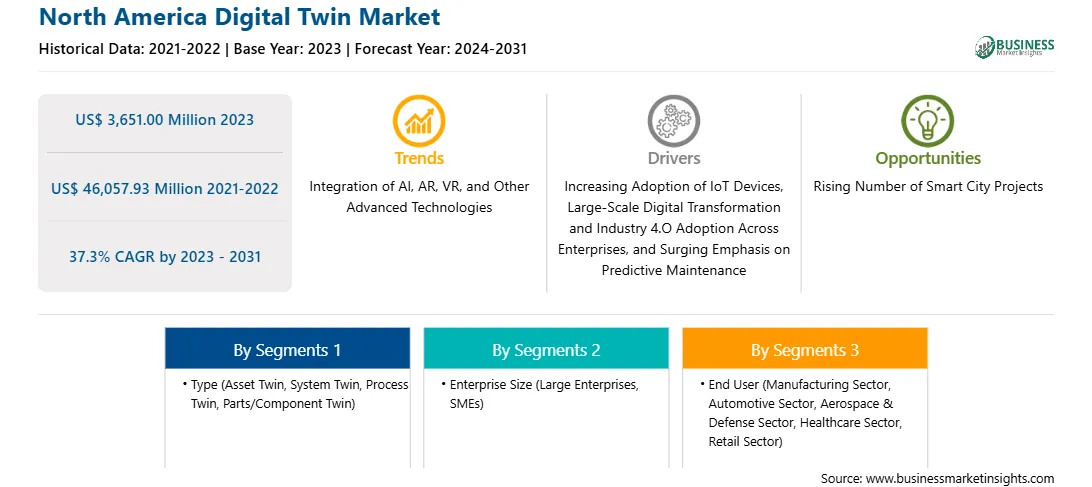北美数字孪生市场预测至 2031 年 - 区域分析 - 按类型(资产孪生、系统孪生、流程孪生和零件/组件孪生)、企业规模(大型企业和中小型企业)和最终用户(制造业、汽车业、航空航天和国防部门、医疗保健业、零售业等)
No. of Pages: 110 | Report Code: BMIRE00031014 | Category: Technology, Media and Telecommunications
No. of Pages: 110 | Report Code: BMIRE00031014 | Category: Technology, Media and Telecommunications
Strategic insights for North America Digital Twin involve closely monitoring industry trends, consumer behaviours, and competitor actions to identify opportunities for growth. By leveraging data analytics, businesses can anticipate market shifts and make informed decisions that align with evolving customer needs. Understanding these dynamics helps companies adjust their strategies proactively, enhance customer engagement, and strengthen their competitive edge. Building strong relationships with stakeholders and staying agile in response to changes ensures long-term success in any market.

| Report Attribute | Details |
|---|---|
| Market size in 2023 | US$ 3,651.00 Million |
| Market Size by 2031 | US$ 46,057.93 Million |
| Global CAGR (2023 - 2031) | 37.3% |
| Historical Data | 2021-2022 |
| Forecast period | 2024-2031 |
| Segments Covered |
By 类型
|
| Regions and Countries Covered | 北美
|
| Market leaders and key company profiles |
The regional scope of North America Digital Twin refers to the geographical area in which a business operates and competes. Understanding regional nuances, such as local consumer preferences, economic conditions, and regulatory environments, is crucial for tailoring strategies to specific markets. Businesses can expand their reach by identifying underserved regions or adapting their offerings to meet regional demands. A clear regional focus allows for more effective resource allocation, targeted marketing, and better positioning against local competitors, ultimately driving growth in those specific areas.

The North America Digital Twin Market is valued at US$ 3,651.00 Million in 2023, it is projected to reach US$ 46,057.93 Million by 2031.
As per our report North America Digital Twin Market, the market size is valued at US$ 3,651.00 Million in 2023, projecting it to reach US$ 46,057.93 Million by 2031. This translates to a CAGR of approximately 37.3% during the forecast period.
The North America Digital Twin Market report typically cover these key segments-
The historic period, base year, and forecast period can vary slightly depending on the specific market research report. However, for the North America Digital Twin Market report:
The North America Digital Twin Market is populated by several key players, each contributing to its growth and innovation. Some of the major players include:
The North America Digital Twin Market report is valuable for diverse stakeholders, including:
Essentially, anyone involved in or considering involvement in the North America Digital Twin Market value chain can benefit from the information contained in a comprehensive market report.